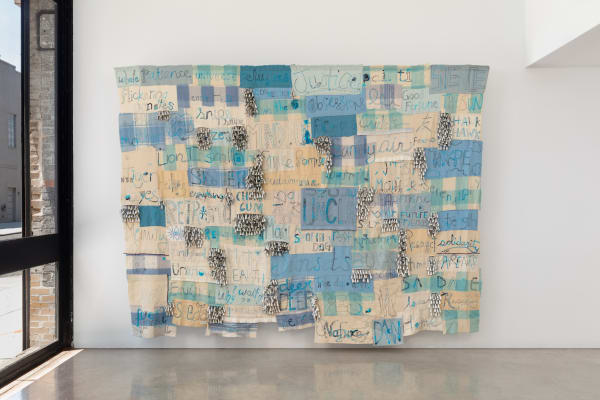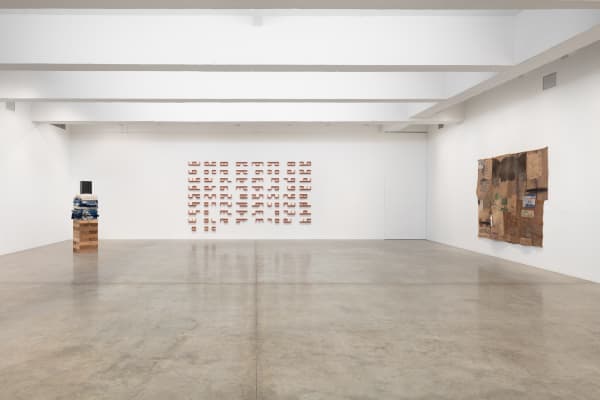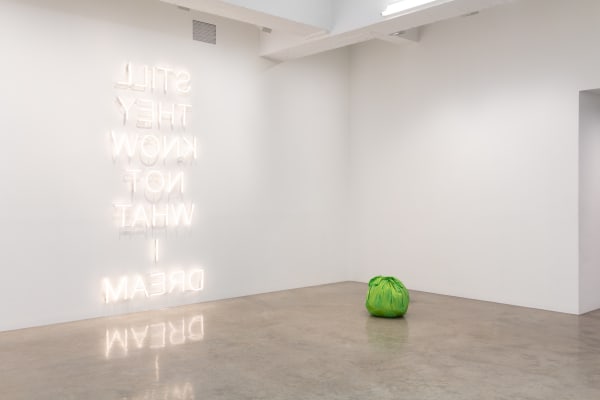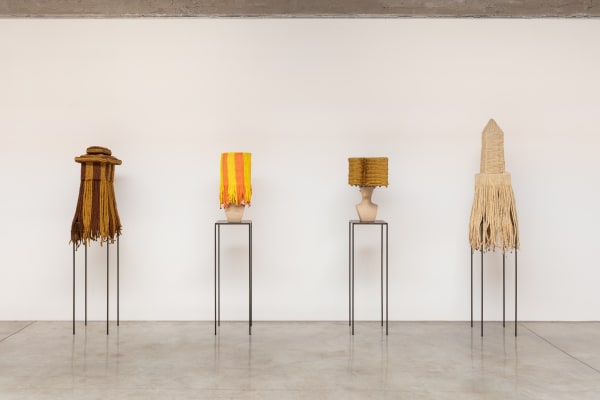Meschac Gaba
Ximena Garrido-Lecca
Shilpa Gupta
Brian Jungen
Kimsooja
Laura Lima
Patrick Martinez
Moris
Rivane Neuenschwander
Clarissa Tossin
Marie Watt
Héctor Zamora
Tanya Bonakdar Gallery is pleased to present The Objects We Choose, curated by Pedro Alonzo, an exhibition featuring important work by Meschac Gaba, Ximena Garrido-Lecca, Shilpa Gupta, Brian Jungen, Kimsooja, Laura Lima, Patrick Martinez, Moris, Rivane Neuenschwander, Clarissa Tossin, Marie Watt, and Héctor Zamora.
As consumers who navigate existence through a continuous process of selecting one thing over another, we know that objects have meaning that transcends their utilitarian and material value. The items that surround us, some of which we choose to use or wear, say a lot about us. Likewise, artists select certain items from which to make an artwork because of their significance, which in turn can give specific meaning to their work. The exhibition consists of works by a range of artists who use ordinary, everyday articles as the raw material for artistic expression. Shoes, neon signs, hats, clothing, wigs, terracotta blocks and blankets are refashioned and transformed into works of art, privileging their symbolism over intended use, making clear that what objects do, is often surpassed by what they represent.
In the first-floor gallery, the Mexican artist Moris’ assemblage combines various sorts of food containers including burlap sacks used to carry beans and maize with flattened boxes of sugary juice and corn chips, contrasting Mexico’s traditional diet with the prevalence of unhealthy foods. The title, La Última Cena (“The Last Supper”) refers to a brand of rat poison also featured in the work. Also working with food packaging, Deadline Calendar by Rivane Neuenschwander reflects on the notion of time by documenting a year of expired food, displaying "Best Before" dates from August 1st 2001 to July 31st 2002. These dates dictate our purchasing habits and raise important questions about food waste, reflecting broader consumer patterns where the lifecycle of products is pre-determined by labels rather than necessity or the state of the food.
Héctor Zamora’s carefully arranged, cut terracotta bricks simultaneously celebrate the achievement of cooking earth to create a material for construction while relating to modernity via the ubiquitous grid, with multiple geometric permutations that can unfold by altering sections of the brick. Also utilizing construction materials to reference modern architecture, Marie Watt’s Skywalker/Skyscraper (Rattle) combines reclaimed blankets and a steel I-beam to recall the Iroquois iron workers - or Skywalkers - who built many of the skyscrapers in New York City. In the work of Watt and Kimsooja, materials are used to highlight cultural traditions and nationality. Watt’s reclaimed blankets reference the Seneca tradition of gifting blankets to mark important life events, while Kimsooja’s round Bottari sculpture deploys a traditional Korean custom of wrapping personal belongings as a metaphor for the universal concept of home and migration.
Economic matters and social systems are also explored. The corn cob sprouting from a cube composed of an assortment of crushed copper products in Ximena Garrido-Lecca’s Rastrojo signals the challenge of extracting natural resources that encroaches upon habitable land. Copper is Peru’s largest export, the mining of which displaces communities and reshapes traditional lifestyles symbolized by the maize. Rendered in neon, Shilpa Gupta’s StillTheyKnowNotWhatIDream is a defiant statement at a time of rising nationalism and growing governmental control and surveillance in her native India and across the planet, affirming that our dreams and minds will always be ours. Meanwhile, Marie Watt’s quilt, Singing Everything: Crescendo (Staccato), was conceived as a collaborative project with the Whitney Museum, inviting the public to respond to the question “What do you want to sing a song for in this moment”. The project culminated in a sewing circle with over 300 participants, resulting in what the artist describes as a registry of “energy and intention”, inscribing the responses on over 100 reclaimed wool blankets.
The use of goods as art-making materials transcends national boundaries and cultures. It allows for artists to contrast the natural world with synthetic materials, traditional forms of creation with mass production, or ancient world views with consumer society. For instance upstairs, the Brazilian artist Laura Lima’s Communal Nest series transforms straw hats into surreal dwellings for birds in an effort to challenge the human tendency to disregard other species who co-inhabit our planet, while Patrick Martinez questions asymmetrical economic structures and hierarchies of power in a series of neon signs common to Main Street storefronts.
Braiding and weaving are millennial traditions used by several artists to decry a system of global trade that supports economic imbalance. Meschac Gaba does so by braiding synthetic hair into wigs the shape of architectural symbols of power including the Washington Monument and the Kennedy Center. Brazilian-born Clarissa Tossin’s Entanglement series hones in on the mega online retailer Amazon.com: using strips cut from their branded boxes combined with cut glossy photo paper, she creates baskets that feature traditional motifs used by Indigenous people of the Amazon basin on one side and the retailer’s corporate logo on the other. Garrido-Lecca weaves cut copper tubes in Aleaciones con memorial de forma: warmi (“Alloys with shape memory”) to create a tapestry based on Andean culture textile motifs that symbolize femininity.
Finally, in Brian Jungen’s Broken Arrangement series, Nike Air Jordan’s are dismantled and reassembled into abstract sculptures that signify both a break with figuration and power often abused by corporations and governments who have historically exploited workers and violated treaties with Native Nations.
These works inevitably question the narratives that support the excesses of capitalism and unbridled and extractive economic models. The artists draw from the material excess of consumer society to present a shift towards alternative worldviews that are environmentally conscious and more equitable than the prevailing modes of thinking, perhaps even nudging us to reconsider our behavior.
Essay by Pedro Alonzo
Photo by Pierre Le Hors













